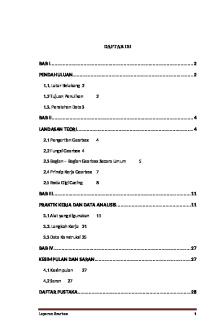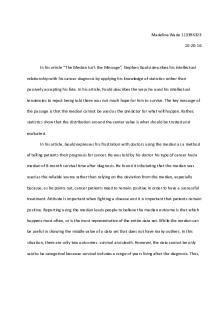The Message Box Exercise PDF

| Title | The Message Box Exercise |
|---|---|
| Course | Science Communication |
| Institution | McMaster University |
| Pages | 5 |
| File Size | 155.7 KB |
| File Type | |
| Total Downloads | 107 |
| Total Views | 164 |
Summary
It talks about how to create a science blog or other article organized and interesting for the audience to read....
Description
The Message Box Exercise
This tool (made by COMPASS) will help you distill down your science and break apart the standard why that scientists communicate with each other (e.g. intro, methods, results, etc)
The message box has 5 sections. Below you will find a description of what each section is about and how to fill it out.
1
1. The Issue section is in the center of the box iden identi ti tifies fies and describes the overarching issue or topic that you’re addr addressing essing in broad terms. It’s the big big--picture context of your work. This shoul should d be very concise and clear; no more than a short phrase. You might want to you revisit tthe he Issue aft fter er you’ve filled out your Message Box, to see if your thinking on the overarching topic has changed since you started. Qu Question estion estion:: How broad/narrow is too broa broad/narrow? d/narrow?
The Issue needs to be broad enough to encompass the key points you want to get across, but specific enough that it sets up what’s to come. The Issue can frame’ the rest of your Message Box, so while it seems very simple, it’s still important for signaling the scale, severity, or significance of your message. Question: My rese research arch paper is only one small part of this topic. Is that okay?
Yes. Putting your research paper into the broader context helps you to take a step back and articulate the other parts of the Message Box and why they should matter to your audience. It can also help guide you as you work through the Message Box. Often, one piece of the Message Box will feel very clear, the others, maybe not so much. So taking a broader view and thinking about the national or international context can be helpful. 2. The Problem is the chunk of the broader issue that your research p pape ape aperr
address addresses es es.. It’s a piece of the pie, reflec reflecti ti ting ng the work and expert knowledge in your paper that is part of the big bigger ger issue issue.. Think about the research questions and what aspect of the specific problem the researchers address addressed ed and why it would matter to your audience. The Problem is also where you set up the So What and describe the situa situati ti tion on that the rese searchers archers identified and wanted to address. ? Problem? Question: What iiff there’s more than one Problem
There might well be more than one Problem the researchers were seeking to address—the world is complex and nuanced. And some problems have several key components. Consider whether you need to talk about two problems with this audience. If one of these problems is more urgent or important than the
2
other, use that as your main problem, and spend less time on, or leave out, the second problem. It is better to focus on just one problem per audience, but it all depends on the context. If this is a situation where you feel you can include more information, give it a try. But be judicious and mindful of what will be relevant and useful to the audience you’re targeting. Question: How can I fi find nd the Problem ? Problem?
Often the Problem is their research question. A problem might also reveal itself through a troubling trend in the data, or a situation that will have a negative effect on people or the environment.
3. So What?- Crux of the paper. Think about why should your audience care? What abo about ut your research pap paper er is important for them to know? Why are you ttell ell elling ing to them about it? The answer to this ques questi ti tion on may change from audience to audience, and you’ll want to be abl able e to adjust based on the audience audience’s ’s interests and needs. than n one reason to care in my So What section section? ? Question: Can I include more tha
Yes. Just be sure to keep each example succinct, and remember to stick to three to five ideas total. Question: How can I be sure my audi audience ence will care about the resea researrch I am telling them about about? ?
Think about your audience to gain insight on what aspects of the work will be relevant to them. But it’s helpful to remember that most audiences will not be as interested in the scientific or theoretical aspects of the research paper, and certainly not the details and nuances. They typically are more interested in the practical or emotional aspects. Consider how the paper’s results can affect their lives—if not now, then in the future— and how you might appeal to their hearts as well as their minds. Sharing your own passion for your chosen paper, and why you care, can often help you reach others. Remember that if your audience is non-scientists, then consider what aspects of your work might resonate with them.
3
4. The Solu ti on sec secti tion outlines the options for solving tthe he problem Soluti tion iden identi tified. When presenting possible solutions, consider whether the solu soluti ti tions ons are something your audience can influence or act upon. And remind yo yourself urself of your communica communicati ti tion on goals: Why are you commun communicati icati icating ng with this audience? What do you want to accomplish? ti on sec secti ti tion? on? Soluti tion Question How many ideas should I have in the Solu
There may be several ideas you want to include—just make sure that they are all relevant to the particular audience and the specific problem(s) you are addressing, and are stated succinctly. But remember, the Message Box is intended to help you prioritize what is most important to convey, so think hard about that. Also consider whether your Problem statement is too broad and could be more specific. In some cases, revisiting the Problem statement can help narrow down the focus of the topic and what needs to be done to address it. Questi Question: on: What if the only Solu ti on that I can th think ink of is simply more research? Soluti tion
The solution in some cases might simply be to obtain a greater understanding of X, Y, or Z. But in many cases, having this as your only Solu ti on is an indication Soluti tion that the Problem statement or the So What needs further distillation. Consider whether either (or both) of these sections are too in-the-weeds of your audience, and aren’t framed as topics that matter in people’s lives. Try to rework them to make sure that they are relevant to your audience. Questi Question: on: What if my Solu ti on doesn’t really impact the Problem ? Soluti tion Problem?
If your Solu ti ons don’t relate to the Problem you identified, then either adjust Soluti tions Soluti tion ti on so that they do relate. Some questions to the Problem or adjust the Solu ti on points are operating at the oluti tion consider include whether your Problem and Solu same scale (i.e., if the problem is that wildlife aren't able to move vast distances across the country due to barriers, but your solution is to have town hall meetings in only one National Park or province, you would need to adjust the scale of your suggested solution. Another question to consider might be whether your Solu ti on is specific enough, or if it is stated too vaguely to actually Soluti tion solve the Problem .
4
5. In the Benefit sec secti ti tion, on, you list the benefits of addres addressing sing the Problem —all Problem— the good things that could happe happen n if your Solu ti on sec secti ti tion on is Soluti tion impleme implemented. nted. This ,es into the So What of why your audience cares, but focuses on the posi positi ti tive ve results of taking ac acti ti tion on (the So What may be a nega negati tive thing thing— —for example, inaction could lead to consequences that your audience cares about). If possible, it can be helpf helpful ul to be specific here here— —concrete examples are more compelling than abstract. Who is likely to benefit, and where, and when? Benefits.. Is that a problem? Question: My So What is similar to the Benefits
No that’s not a problem. The Message Box is a sorting tool to help you decide what is most important. You may end up with only three key messages, or even less. It’s not about filling the boxes, it’s about deciding what is the most important thing to say, out of all the things you could say. If the So What and Benefit are similar, that’s fine. But make them relevant to your target audience. Question Question:: What if the only Benefit I can think of applies to future researc researchers? hers?
For an audience of non-scientists, try to think about how your research could connect back to the So What. If this was basic research that told you something new about the world, consider the applications down the road that this audience might care about, or why these discoveries might connect with them emotionally. Question Question:: How do I avoid over over--promising the Benefit ? Benefit?
Often, societal and environmental benefits accrue through a combination of efforts, approaches, and solutions. Your work might only be one part of that larger solution. It’s okay to identify the larger-scale benefits your work will contribute to. Just make it clear that the solutions you’ve identified are only one piece of the puzzle. You might also revisit your Problem statement and make sure that it’s appropriately scaled for the Solu ti on identified. If necessary, you Soluti tion can include qualifiers such as “could,” though be prudent with your caveats and only use them when you really have to.
5...
Similar Free PDFs

The Message Box Exercise
- 5 Pages

The Box Model - lec
- 34 Pages

Pandora\'s Box: The Story
- 3 Pages

Routine Message
- 3 Pages

Gear box
- 18 Pages

White-Box
- 10 Pages

GEB3213 Persuasive Message
- 2 Pages

Negative Message Karen
- 1 Pages
Popular Institutions
- Tinajero National High School - Annex
- Politeknik Caltex Riau
- Yokohama City University
- SGT University
- University of Al-Qadisiyah
- Divine Word College of Vigan
- Techniek College Rotterdam
- Universidade de Santiago
- Universiti Teknologi MARA Cawangan Johor Kampus Pasir Gudang
- Poltekkes Kemenkes Yogyakarta
- Baguio City National High School
- Colegio san marcos
- preparatoria uno
- Centro de Bachillerato Tecnológico Industrial y de Servicios No. 107
- Dalian Maritime University
- Quang Trung Secondary School
- Colegio Tecnológico en Informática
- Corporación Regional de Educación Superior
- Grupo CEDVA
- Dar Al Uloom University
- Centro de Estudios Preuniversitarios de la Universidad Nacional de Ingeniería
- 上智大学
- Aakash International School, Nuna Majara
- San Felipe Neri Catholic School
- Kang Chiao International School - New Taipei City
- Misamis Occidental National High School
- Institución Educativa Escuela Normal Juan Ladrilleros
- Kolehiyo ng Pantukan
- Batanes State College
- Instituto Continental
- Sekolah Menengah Kejuruan Kesehatan Kaltara (Tarakan)
- Colegio de La Inmaculada Concepcion - Cebu







